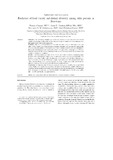Please use this identifier to cite or link to this item:
http://hdl.handle.net/10311/212Full metadata record
| DC Field | Value | Language |
|---|---|---|
| dc.contributor.author | Clausen, T. | |
| dc.contributor.author | Charlton, K.E. | |
| dc.contributor.author | Gobotswang, K.S.M. | |
| dc.contributor.author | Holmboe-Ottesen, G. | |
| dc.date.accessioned | 2008-09-03T10:54:16Z | |
| dc.date.available | 2008-09-03T10:54:16Z | |
| dc.date.issued | 2005 | |
| dc.identifier.citation | Gobotswang, K.S.M. et al (2005) Predictors of food variety and dietary diversity among older persons in Botswana, Nutrition 21 pp. 86-95 | en |
| dc.identifier.issn | 0899-9007 | |
| dc.identifier.uri | http://hdl.handle.net/10311/212 | |
| dc.description.abstract | Objective: We investigated whether food variety and diversity are associated with physical and cognitive functioning in older adults in Botswana and designed a simple set of screening questions that predict food variety in this population. Methods: Data were collected (1998) as a national household survey of 1085 subjects 60 y and older. A food variety score, based on a food frequency checklist, was calculated by summing the frequency of weekly intakes of 16 food items (0 to 66). A dietary diversity score was calculated as the number of food groups consumed weekly (0 to 5). A representative subsample (n = 393) was randomly selected for the clinical component of the survey, and measurements on dependency and cognitive function were conducted. Results: Low food variety was found: 35.2%, 59.3%, and 22.4% of subjects consumed no dairy products, fruits, and vegetables, respectively. A higher food variety score was associated with urban residence, ownership of cattle, higher education, and more frequent meals, and these indicators were used to construct a nutritional risk indicator. Higher food variety score was associated with better self-reported health and better cognitive function. Similarly, a higher score on the nutritional risk indicator screening tool was associated with desirable health outcomes. Conclusion: A limited number of foods is consumed, leading to an overall pattern of poor food variety. Higher food variety was associated with improved physical and cognitive functions. A screening tool that predicts food variety in this population has been developed and is recommended to be incorporated at a primary care level to identify older adults most at risk of a poor quality diet. | en |
| dc.description.sponsorship | The project was funded by the Norwegian Council of Universities/ Centre for International University Cooperation (NUFU). | en |
| dc.language.iso | en | en |
| dc.publisher | Elsevier; www.elsevier.com/locate/nut | en |
| dc.subject | Elderly | en |
| dc.subject | Food variety | en |
| dc.subject | Dietary diversity | en |
| dc.subject | Nutritional | en |
| dc.subject | Botswana | en |
| dc.subject | Screening instrument | en |
| dc.title | Predictors of food variety and dietary diversity among older persons in Botswana | en |
| dc.type | Article | en |
| Appears in Collections: | Research articles (Dept of Family and Consumer Sciences, formerly Home Economics Education) | |
Files in This Item:
| File | Description | Size | Format | |
|---|---|---|---|---|
| Gobotswang_N_2005.pdf | 2.42 MB | Adobe PDF |  View/Open | |
| license.txt | 1.95 kB | Text | View/Open |
Items in DSpace are protected by copyright, with all rights reserved, unless otherwise indicated.
